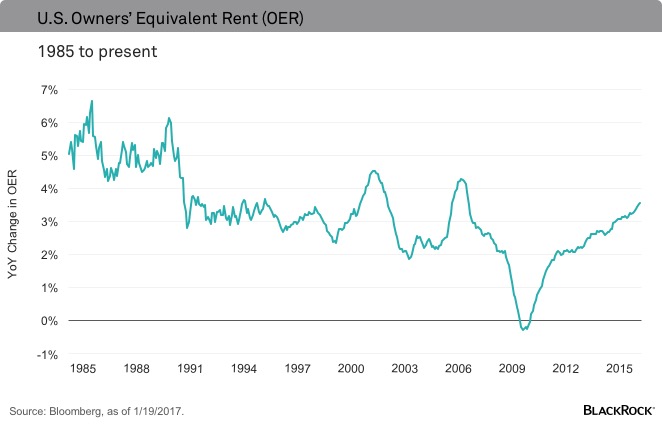Written by Russ Koesterich, CFA
Like the proverbial frog that does not notice the rise in water temperature until it’s too late, investors seem to be experiencing a similarly stealthy rise in inflation. Changes in headline inflation measures suggest a gentle firming in prices. However, underneath the surface there is evidence that inflation may continue to rise past the steady 2% nirvana that central banks prefer. Consider the following:
1. Housing costs are now rising at the fastest pace in nearly a decade.
Housing is a major component of core inflation, i.e. inflation without volatile food and energy prices. The main housing component in the Consumer Price Index (CPI) is Owners’ Equivalents Rent (OER). As overall housing costs make up over 40% of core inflation, this is a key metric to watch. Last December OER rose over 3.5% from the previous year, the quickest pace in nearly 10 years (see the accompanying chart).

2. Medical inflation is not as contained as many had hoped.
A few years back it seemed that medical costs were finally under control. That conclusion now appears premature. CPI for medical care has been rising at roughly 4% year-over-year for the past six months. With the exception of a brief period in 2012, medical costs have not been rising at this rate since early 2008.
3. Wages are rising.
One of the defining aspects of this recovery has been persistently sluggish wage growth, even in the face of a strong labor market. That is slowly changing. While still muted by historical standards, average hourly earnings are rising by 2.9% year-over-year, the fastest pace since the spring of 2009. A potential bolster to the trend: 20 states raised their minimum wage rates as of the first of the year.
4. Consumer inflation expectations are also starting to tick higher.
Up until recently consumer expectations for inflation remained muted. This was arguably a function of plunging oil and gasoline prices, which seem to exert an oversized importance in consumer perceptions of inflation. With oil and gasoline more stable, expectations are changing. The University of Michigan’s one-year inflation expectation survey is now at 2.6%, up 0.4% from the previous month.







